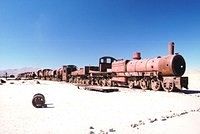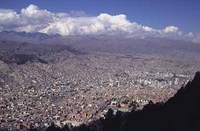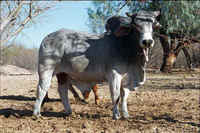The Salar de Uyuni (Salt Flats) tour we went on was absolutely incredible. The first day was my favorite, as we raced through the actual salar (the following days were in the altiplano). The Salt Flats are at an elevation of 12,000 ft. and cover 8,000 sq. miles – pretty incredible. The salt is 7 meters (about 23 feet) thick and blindingly white, much like fresh snow. I imagine it ´s much like being on Antarctica, only it ´s slightly above zero during the day instead of -40.
Before we left town, we stopped at the Train Cemetery on the Uyuni city limits. We were skeptical at first… it sounded mostly like another thing to add to the itinerary so you think you ´re getting more for you money. We expected nothing more than a junk pile of metal, but were surprised to find the ghost of history in all of the rusting steam engines used to haul silver and lead in the sixties.

The haunting train cemetary at the edge of town. We saw the kind of tourists that give gringos a bad name writing “The English were here, 2006” (in Spanish, of course) on a train. Jerks.
The average view on the journey across the immense salar. Amazing and surreal. Trippy, even.
Our next stop was at the edge of the salar where they are mining the salt completely by hand. Our guide didn ´t know anything, so I approached one of the miners with my questions. Having worked in a mining environment, I was shocked at the lack of machinery to do anything. Men, with a tool that looks much like a hoe, scrape the salt into piles three to four feet tall. They let them sit for a few days so the moisture drains out. Then, they drive a mini dump-truck along side the piles and hand-shovel it all into the back of the truck. The salt is then taken to a refinery in a town to the north and mixed with other minerals and better salt before it is sold as table salt or mixed with sugar water to make a kind of cement. The miners get about $2 a ton, which is 17 Bolivianos – roughly the cost of a pair of gloves here. I wasn ´t able to ask how many tons they shovel in a day, but I can ´t imagine it would be more than 10 or 15. The miners were incredibly friendly (it ´s hit and miss with the locals here), and when I asked to photograph the truck, they let Pat shovel a pile ´s worth of salt into the back end. Afterwards I got my turn, too. It weighs about as much as snow, so for those of you in areas with real winters, just imagine shoveling your driveway all day long.
The amazing cactus-covered Isla Pescado in the middle of the Salar. Each cactus grows 1 meter (3 feet) every 100 years. Some are over 1200 years old!
Of course, before we got back in the Toyota Land Cruiser, we had to taste the unfinished product. Surprisingly not that salty, but blindingly white nonetheless. We raced across the expanse until we arrived at the most famous of the salt hotels. All the buildings in the salar are made of salt blocks and the salt cement. And all the furniture is made of salt (tables, chairs, bed shelves, etc.) The salt hotel had some really awesome dining furniture inside these coves. It was basically a bench against a wall, but there was a rounded seat back of salt for each person… very medieval looking. Outside, we found some Bolivian tourists taking funny pictures. The immense white background allows for some pretty awesome camera tricks.
The medieval seating at the first salt hotel.
Next, we were off to an island in the middle of the salar. We spotted it well before we arrived. It is almost impossible to judge distance in such a homogenous setting. I felt like I was on a movie set… like the Truman Show. The island really helped us imagine the archaic lake that used to cover the area. The salt literally looked like surf washing up on shore. The island is covered in ancient cacti, petrified coral, and volcanic rock. After picking up a pair of funky earrings from a local artisan, we hiked up to the high point of the island to have a look around. I don`t know if it`s the type of cactus or the climate it`s growing in, but these cacti only grow 1 meter (a little more than a yard) every 100 years. Which means we got to see cacti that were well over 1000 years old. Mindblowing!
Good example of what our rooms looked like. I don`t know this woman. 🙂
Lunch was held at the picnic tables made of salt on “shore.” I would never have ventured to mix plain pasta with chunks of avocado, tomato, and cucumber, but it was delicious! We packed up and headed for our nighttime digs at the edge of the salar. The hotel we stayed in was really cute. It`s really amazing how absolutely everything is made of salt! Even the mattresses are on giant salt shelves. It was dorm style with three bedrooms coming off the dining/common area; six beds to a room.
A vicua (pronouced v-eye-coon-yuh) grazing on the altiplano (high plain).
We had some wonderful hot drinks to accompany our early evening journalling before we all ran outside (brrrrr!) to see the sunset over the salar. Beautiful, clear days like the one we had don`t do as much for sunsets as cloudy days do, but the colors were still magnificent. For dinner, we had some absolutely incredible vegetable soup (I can`t believe I forgot to get the recipe!) and some not so incredible chicken, rice, and greasy greasy greasy fried potatoes. We sat around the salt tables for the rest of the evening playing cards, drinking wine, and eating oreos with three wonderful young austrailian women who were part of our group of six that was continuously cramming into the Land Cruiser.
Endangered Andean flamingos. I don`t know how these things don`t freeze their feathers off.
The next morning we were up in time for the sunrise, which is absolutely magical in a place so other-wordly. Breakfast cake, yogurt, and cornflakes were on offer as well as some excellent hot chocolate (cum mocha if you so desired). Side note: the entire trip around the salar was almost 1000 km, so 700ish miles. As a result, we did a lot of driving through some amazing country on some not-so-amazing roads. The second morning was no exception as we high-tailed it through the altiplano (goodbye salt flats! 🙁 miss you!) past quinoa fields and wild vicuñas (they look like a cross between llamas and antelope – you go to jail for thirty years if you kill one.) For about three hours we cruised across land so high with no plantlife whatsoever, and volcanic rocks galore that we felt like we were on the moon.
The Arbol de Piedra… or tree of stone. Pretty nifty!
Finally we arrived at the viewpoint, a collection of giant, wind-weathered rocks that faced the toe of an active volcano puffing in the distance. Once again we had a run-in with tourism habits that give gringos such a bad rap. Used toilet paper was everywhere. You`d think someone with a first-world education and/or money to travel would be smart enough to know that toilet paper doesn`t decompose at 13,000 feet and that leaving it anyway is just appallingly disrespectful. Makes me absolutely furious. I just want to run around lecturing all these people!
The infamous Laguna Colorada, and the 1/2 way point on the trip. The micro-organisms in the water make it this color.
Anyway, more sitting in the Land Cruiser follwed as we passed several high alpine lakes, one chock-full of a mineral used to make detergent. Finally we arrive at our lunch spot and got to see our first Andean flamingos. Bet you thought flamingos were only tropical birds. Me too. But, no! The minerals around the lake are quite sulfurous and the ground itself is terribly soft. Our guide warned us not to venture out across the stepping-stone islands, as most tourists who don`t listen end up sinking in the soft mud up to their belts. The mountain winds blasted us as we hovered around the shore line waiting for lunch to be ready. Out cook was wonderful and prepared the meal in the back of the land cruiser. Most the other tour groups got lunch that was 1/2 food and 1/2 blowing sand. Lunch was delicious… cauliflower patties (who woulda thunk?), boiled potatoes, peas, and carrots, mixed with the standard avacado and tomato. Mmmm….
The mountain of seven colors… why do photos never do real justice to nature`s beauties!
Seeing as patience is not my strong suit, the next couple of hours in the vehicle were particularly rough for me. Sometimes I`m just overcome with antsy, child-like energy. I got to take most of it out on Pat. We played a long round of the ABC game, I sang him songs, told him stories, and then tackled him repeatedly once we finally got the the Arbol de Piedra (tree of stone) weathered by the wind. We got a neat picture with me on his shoulders under the “tree” before hustling around to all the other nifty rock formations.
A rather shoddy photo of the place the jeeps stop in the Valley of the rocks. This is just a great view point, but the valley itself is breathtaking.
Finally, we passed through on last stretch of desert with a beautiful “mountain of seven colors” watching over us. Reds, browns, whites, greys, and a little pink and purple made for a spectacular sight. Awhile later, we rounded the bend to Laguna Colorada (Red Lagoon… the real word for red is rojo, but colorada is a shade of red – kind of like we say magenta and fuschia). We had to pay an entrance fee to the park (it`s one of Bolivia`s 22 preserved areas) before dropping off our stuff and heading for a walk around the red lake, complete with more flamingos!
We had more wonderful vegetable soup along with Bolivian spaghetti (sauce more like salsa) for dinner and free wine compliments of the company. The spoiled rich kids, all U.S. pre-med undergrads from various ivy-leagues spending a $5000 summer pumping up their resumes in Bolivian health clinics, took it upon themselves to usurp the only heater (a device attached to the end of a propane bottle), so the five of us retired to our room to shiver and play cards until I finally asked the kitchen if we might have another heater. They obliged us, and we spent the rest of the evening playing “golf” (a beefed up version from the one I know) and drinking some inventive rum/vodka cocktails. The generator was shutdown at 8:30, so we all turned in pretty early. Not a bad thing, since we were to be up and loaded by 5:30 the following morning.
We braved the icy morning air, and shivered throughout the hour-long ride the geyers. When you`re from the state that`s home to Yellowstone National Park, it`s tough to be impressed by geothermal activity anywhere else. The “geyers” ended up being fumaroles, mudpots, and one artificial steam vent drilled back in the seventies. Pat and I both did a quick tour through the freezing area (no boardwalks and nothing to keep people away from the 125 degree heat) before jumping back into the Land Cruiser (no heat).
Finally, shortly after sun-up, we arrived at the aguas termales (hot springs) where those who are a few bricks short of a load can strip down in the below-zero temps and swim in the 96 degree water. I don`t know how I got talked into it (or did I talk myself into it?), but fifteen mintues later, I was twirling around in my skivvies in the toasty water. I expected to freeze when I got out, but my core temperature was up so high that I was enjoying coffee and scrambled eggs well before I started to feel the chilly air trying to work its way back into my bones.
After breakfast, it was on to the Salvador Dali desert, and finally to the Laguna Verde, which was frozen over, and therefore not so verde (green). It was the birthday of one of the Australian women, so we sang Happy Birthday, loud and proud, before heading to the Chilean border where we dropped off yet another wonderful Aussie for her onward journey. A whole-lotta-driving later, we arrived at a little llama ranch/farm (a shack next to a water hole) and had tasty tuna and rice w/… you`ll never guess. Avacados and tomatoes! Even more driving brought us to a villiage where we tried desperately to work out our antsy by walking the length of the pueblo, but no luck. So back in the car again to drive, drive, drive to the Valley of the Rocks. This place was truly amazing and very much worth seeing. Reminded me of Utah/Nevada Natl. Parks. Really fabulous incredible views. After this, we had two more hours to Uyuni. 30 minutes from town, the driver pulled the car over and announced we were out of gas. Uh oh. They were prepared, however, and lugged a 10 gallon container off the roof for a fill-up.
We arrived safely in Uyuni, and had our guide drop us off at the bus station so we could leave our bags and get dinner before our departure to LaPaz an hour later. Pat and I really didn`t feel like getting on a bus for another 13 hours after bouncing in the Land Cruiser all day long, but we had purchased our tickets already. When we arrived at the station, I discovered that the company had sold our fare to another company and presented us with these tickets. Fine enough. When the Australian women tried to get their tickets though, the woman behind the counter said the tickets hadn`t been paid for (the Aussies bought them through a travel agency) and therefore no seats in their names had been purchased from the new company. Uh oh.
But Then The Unexpected Happened
Seeing as Pat and I didn`t even want to go to LaPaz that night, I asked the counter attendant if we could trade places with the Australians. While I helped with translating and understanding what was going on in the ticket office, Pat waited outside with our bags (as per the usual, although much more scattered than usual as a result of our recent salar tour return). As I was chatting with the women about different possibilities, Pat rushes into the station carrying all our stuff, blankets dangling, etc. and says, “Your bag just got jacked.”
Oh shit. No, not “oh no” or “oh crap” or “oh god” Oh shit.
Pat took off outside, and I followed shortly thereafter. I started to follow him, but realized two pairs of eyes would be better on different streets. So, I ran down the next street, eyes, peeled. I just kept going, searching and searching fruitlessly, until I decided to ask some young men if they knew any mochila (backpack) thieves and could help me get my bag back. Seeing as I don`t have and therefore don`t tote around the standard gringo digital camera, ipod, etc. and I wear my passport and money at all times, there is almost nothing of value in my bag. I was wearing all my clothes minus two pair of socks and four t-shirts. All I had were three used disposable cameras, 1/2 used bottles of shampoo/sunscreen, and all my Portuguese notes and information. Things only valuable to me.
The young men didn`t know anything, so I just kept walking and asking people. Finally some six/seven year old boys told me the bag would be taken to a market and re-sold, probably to another gringo. As for the rest, I was right… probably thrown out. The boys escorted me to the police station, where I was told to come back in the morning at 9 or 10 since I didn`t have a description of the guy. I asked the officer where I should look in the meantime. He said, “that`s what we`ll do tomorrow.” I told him that`s what I wanted to do NOW. So he said just to look around the outskirts of the city and kind of waved me off. Yay Bolivian police.
I decided I better head back to the bus station, since Pat didn`t know the city well and was probably either lost by this time, or sitting there waiting, waiting, waiting for me to show back up. I passed one of the Australian girls come out of the public bathroom. She said, “Pat got your bag back, but he`s been looking for you.” Alleluia!!! I got back to the bus office just after Pat had left in search of me again. I blew my whistle , and Pat came running back in a panic. As soon as my bag got stolen right from under his nose, Uyuni had become a desperate and dangerous place for him, so his mind had been racing with terrible things that might have happened to his girlfriend on one of the dark streets of town. After reuniting and several minutes of, “Oh my god. I`m so glad you`re okay,” Pat explained what happened.
He knows most scams are distraction based in busy areas. Usually someone spits a luggi on your neck or smears sticky junk (like syrup or honey) all over you or your bag. Then, while they are helping you clean it off, their counterpart lifts your stuff. Well, this time the distraction was just conversation. A forty-something guy came up to Pat and started talking to him in Spanish. Since Pat speaks almost no Spanish (he knows basic words from working construction in Gillette), he thought maybe the guy was trying to buy a shovel off the stack behind him. Abruptly the man walked away, which Pat found rather odd. When he glanced back at our pile of stuff, my bag was gone.
After scooping up the rest of the stuff and dumping it in the office, he ran down the sidewalk peering at everyone. Just as he was about to give up, a street worker called him over and said “Amigo… insertspanishthatpatdoesntunderstand” and pointed down the street. So, Pat ran up to and older man (50`s and less than 5 foot tall) carrying a black gunny sack over his shoulder and questioned him with “Amigo, mochila? Amigo, mochila. Amigo, mochila… amigo, mochila.” The guy just kept walking trying to blow Pat off with a little Spanish, which seemed suspicious, so Pat kept up with him and kept saying, “Amigo, mochila- Amigo, mochila.” Suddenly, probably because a gringo-giant was hounding him (Pat was a solid two feet taller than the thief), the guy stopped and dumped the gunnysack out onto the sidewalk, and my mochila spilled into the street. Pat scooped it up as the thief took off running down the street. Relieved that he`d gotten the bag back, Pat offered up a rather comical “gracias” before hightailing it back to the bus station.
At this point, I was probably walking through the carnival downtown, a gringo-free area packed corner to corner with people (like Mardi Gras), hoping to pick up some tips about my bag. So, it was probably a good half-hour before I met back up with the very frantic Patrick. Pobrecito! 🙁
If I didn`t say it already, we ended up definitely changing tickets with Jess and Julie (the Aussies), and after much relieved hugging and smooching, checked into a hotel, showered, and picked up some pizza. What a night!










Twitter Facebook Google+ StumbleUpon Reddit Pinterest